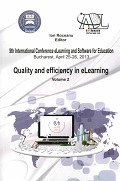CHALLENGES OF INTEGRATING LEARNING GAMES INTO E-LEARNING ENVIRONMENTS
CHALLENGES OF INTEGRATING LEARNING GAMES INTO E-LEARNING ENVIRONMENTS
Author(s): Cezar Vasilescu, Brînduşa Maria Popa, Aura CodreanuSubject(s): Education
Published by: Carol I National Defence University Publishing House
Keywords: learning games; e-learning environments; education; training; advanced distributed learning; blended learning
Summary/Abstract: In traditional educational and training environments learning games play a major role in experiential learning, regardless of their target audience: children, teenagers or adults. However, given the current trends in education and training initiatives world-wide (e.g. blended learning, distributed learning), as well as the requirements of those seeking training and education, words like costeffectiveness, time-efficiency, outcome oriented actions have become the cornerstone for any provider of educational and training programs. Consequently, to adapt to this new world is to be able to merge the useful with the inciting in one or several virtual/e- package(s). Consequently, this article will start by identifying the role of learning games in traditional environments. Next, by focusing on the features of e-learning environments, it will attempt to short-list these roles in accordance with the purposes served by these environments. Worth reminding in this respect is that the design and use of learning games may prove a cumbersome task for trainers and educators. Thus, if in the case of young learners flashy cards, posters, rhymes and chants, etc. can be easily integrated into e-learning environments, with adults finding the right tools for transferring knowledge into a meaningful, easy, funny and yet not simplistic manner may prove a conundrum. To do that, several key roles and responsibilities of the people involved in educational programs (i.e. teachers, trainers, educators, etc.) need revisiting. In this respect, another goal of this article is to discuss the way these roles change and what the new prerequisites for fulfilling them are. Last but not the least, the article will also discuss the characteristics of the disciplines that have actually allowed integrating learning games into e-learning environments. In the end, based on the findings, the authors will overview the lessons learned in the field and make suggestions as to how to best entice e-learners through learning games depending on the discipline, level and age.
Journal: Conference proceedings of »eLearning and Software for Education« (eLSE)
- Issue Year: 9/2013
- Issue No: 02
- Page Range: 121-126
- Page Count: 6
- Language: English

